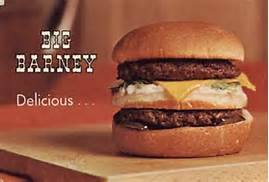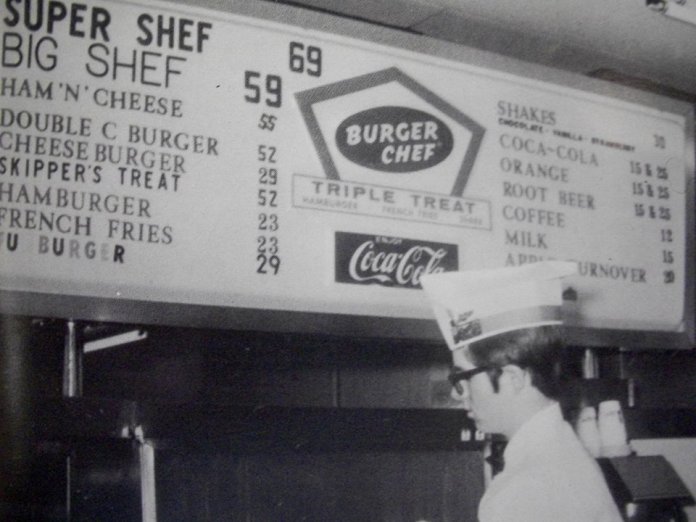
 Burger Chef. All but forgotten today. I only had a few opportunities to sample their cuisine when they had locations I would occasionally pass by on downtown pavement ribbons in places such as Oshawa, Ontario and Brattleboro, Vermont, sometimes just looking for a quick fast-food pit stop on my Honda motorcycle in those days before my Chevrolet Vega, when I would night ride with no windshield but an electric start at least, through the rugged Green Mountains of southern Vermont and pick up a Big Chef (also known as a Big Shef) burger in Brattleboro, if I hadn’t already 70 miles earlier in the far eastern Adirondack Mountains reaches of New York State savored one of the last remaining Red Barn “Big Barney” or “Barnbuster” burgers I could find along a mountainous two-lane stretch of U.S. Route 7, a road that was part of the original plan for the United States highway system approved by the Bureau of Public Roads in November 1926, up in the Adirondacks in Troy, in Rensselaer County, 30 miles from the Vermont state line and the Green Mountains.
Burger Chef. All but forgotten today. I only had a few opportunities to sample their cuisine when they had locations I would occasionally pass by on downtown pavement ribbons in places such as Oshawa, Ontario and Brattleboro, Vermont, sometimes just looking for a quick fast-food pit stop on my Honda motorcycle in those days before my Chevrolet Vega, when I would night ride with no windshield but an electric start at least, through the rugged Green Mountains of southern Vermont and pick up a Big Chef (also known as a Big Shef) burger in Brattleboro, if I hadn’t already 70 miles earlier in the far eastern Adirondack Mountains reaches of New York State savored one of the last remaining Red Barn “Big Barney” or “Barnbuster” burgers I could find along a mountainous two-lane stretch of U.S. Route 7, a road that was part of the original plan for the United States highway system approved by the Bureau of Public Roads in November 1926, up in the Adirondacks in Troy, in Rensselaer County, 30 miles from the Vermont state line and the Green Mountains.
Ever eastbound, across 40 very rugged miles of Route 9 between Bennington and Brattleboro, as I did several times in the Summer of 1979, on my way across the state line at the Connecticut River, and into southern New Hampshire’s Cheshire and Hillsborough counties, riding over the gentler Mount Monadnock of Ralph Waldo Emerson and Henry David Thoreau, as I cruise through New England’s historic Chesterfield, Spofford, Chesterfield Gorge, Marlborough, and Dublin, all the way east along to Peterborough. Where better to contrast, juxtapose and compare the idyllic and slightly mythic New England of the imagination with the second oil crisis, recession looming reality of Jimmy Carter’s late 1970s, than by listening to some of the out-of-state boys from neighbouring New Hampshire Ball Bearings perhaps, as they devour the so-called “Triple Treat,” a burger-fries-and-drink combo meal served real at Burger Chef? The Triple Treat cost just $0.45 cents for the whole combo when it made its debut in Eisenhower era American and the speedy burger-flame griller’s slogan back then was “Burger Chef goes all out to please your family.” By 1973 and the Nixon era, Burger Chef had their “Fun Meal’ for kids with Burger Chef and Jeff and punch-out things you could make from the tray box. Nice. Nuclear families pre- Sixties’ detonation.
Indianapolis-based Burger Chef was launched as a 15-cent burger joint by Frank P. Thomas Jr., Donald J. Thomas and Robert E. Wildman, owners of the General Equipment Manufacturing Company in 1958, originally just as a demonstration restaurant to showcase the restaurant equipment manufactured by their company, as they tried creating more efficient technology to make burgers and shakes. Burger Chef opened with a conveyor broiler that was said to be able to make 800 flame-broiled patties with ‘cook out flavor’ per hour, as well as being equipped with equally prolific automated milkshake blending machines.
By December 1967, Burger Chef had become the second largest restaurant chain in the United States, trailing only McDonald’s. In 1969, after being acquired by General Foods a year prior, Burger Chef opened its 1,000th restaurant and by 1971 the chain had grown to 1,200 locations, second only to McDonald’s, which had less than 1,300 locations, meaning fewer than 1,000 restaurants separated the two burger behemoths in that year of the “Nixon Shock” almost 45 years ago, including the August abandonment of the gold standard and sound dollar monetary policy forged at the United Nations Monetary and Financial Conference at Bretton Woods, New Hampshire in July 1944.
The Nixon Shock. The peaking of Burger Chef. Their presents seemingly about to soon pass into history in opposite directions in the Summer of 1971. Seemingly. Burger Chef, in fact, while it went unseen at the time, was about to quickly peak and slide nary a grease stain almost into the annals of American fast-food history, as chronicled in John P. McDonald’s 2011 book, Flameout: The Rise and Fall of Burger Chef. It is the story of the greatest might-have-been in the history of the fast food business.
Burger Chef, a fast food restaurant begun almost by accidental afterthought, but which had become the industry’s innovation leader in just two years by 1960, would only a dozen years later begin its lost decade of most of the 1970s, aside from 1970, 1971 and 1972, right at the moment seemingly of their greatest success, as too rapid expansion, as it turned out, not surprisingly but still unfortunately lock-step with process and control systems, replaced earlier innovation and entrepreneurship.
You can catch a 1979 television commercial for Burger Chef, courtesy of The Museum of Classic Chicago Television, here at: http://www.fuzzymemories.tv/?c=3209#videoclip-4440
In 1982, Burger Chef was sold to Hardee’s Food Systems, Inc., a food restaurant chain, operating primarily in the South and Midwest.
Some Burger Chef aficionados say the last Burger Chef closed in Madison, Wisconsin in 1996. TIME magazine, however, says the last Burger Chef franchise closed in Cookeville, Tennessee in 1996 and was converted into a Pleasers restaurant. If nothing else, there is general agreement the last Burger Chef closed 20 years ago.
Scott R. Sanders, an elementary teacher for the Alvin Independent School District in Alvin, Texas, has some amazing Burger Chef photos on his website “Burger Chef Memories” found at: http://www.freewebs.com/burgerchef/
When the last restaurant closed is part of the arcana fast-food joint pop culture fans love to debate in online forums, always holding on to a glimmer of hope that somehow, somewhere one last remaining Burger Chef, Red Barn or Mother’s Pizza – you name it – remains, or has risen from the ashes of a chain’s untimely closure, cooking up their favourite food to serve loyal burger, fry and shake patrons.
Red Barn, founded in 1962 in Springfield, Ohio by Don Six, Jim Kirst and Martin Levine, had restaurants in the shape of barns with a glass front and limited dining room seating, peaking in its heyday in the early 1970s with more than 400 restaurant locations in 22 states, as well as locations in Canada, and even a dozen in and around Melbourne, Australia.
Servomation bought the company from Foodcraft Management in the late 1960s and then City Investing bought Servomation in 1979. Motel 6 bought Servomation in 1979. By 1987, Red Barn was down to 15 locations after filing for bankruptcy protection in January 1986.
Red Barn was the first major fast-food chain to have self-service salad bars and its chicken and fish were fried in pure vegetable oil.
Until quite recently, when it proved no longer viable, Alan Priest’s Farm Family Restaurant in Bradford, Pennsylvania did a magnificent job of recreating Red Barn offerings, especially the fried chicken, in a valiant effort to keep Red Barn memories alive. Former Red Barn employees from locations across both the United States and Canada would make a point of stopping off in Bradford if they were traveling anywhere at all in the area; many went even further, making destination-end pilgrimages to the Farm Family Restaurant in Bradford, Pennsylvania.
Occasionally a fast food resurrection does seeming miraculously happen against all odds.
Case in point. Mother’s Pizza had been founded in Hamilton, Ontario in 1970 by three partners, Grey Sisson, Ken Fowler and Pasquale Marra, and got its start in the Westdale Village area of Steeltown. Mother’s was an iconic Canadian pizza parlour chain from the 1970s – with its swinging parlour-style doors, Tiffany lamps, antique-style chairs, red-and-white checked gingham tablecloths, black-and-white short silent movies shown on a screen for patrons waiting for their meal to enjoy, root beer floats and pizzas served on silver-coloured metal pedestal stands.
Sadly, things eventually went south on the business end, and not south as in more geographic expansion. No more Mother’s. For years. But in 2008, Brian Alger acquired the then-expired trademark to Mother’s Pizza – one of his favourite childhood brands – and along with another entrepreneur, Geeve Sandhu, re-opened April 1, 2013 at 701 Queenston Rd. in Hamilton, Ontario. Three years later, the pizza maker with a second life, has expanded into nearby Kitchener and Brantford.
You can also follow me on Twitter at: https://twitter.com/jwbarker22




